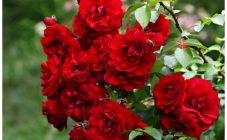Content:
This variety will soon turn 100 years old, during which it was the best among striped roses. Despite its venerable age, the rose Ferdinand Pichard is still loved and in demand, and the two-color varieties obtained on its basis surpassed the mother variety, which only proves its excellent qualities.
Characteristics and features of the park variety
A hybrid of French selection bred in 1921 by J. Tannet. A distinctive feature of the variety is its striped flowers. When blooming, they are pink-red with longitudinal pale pink stripes. Then they fade in the sun to white, and the red areas become dark carmine, increasing the contrast.
What roses are called park roses? This is a type of rose that does not need special shelter for the winter. The most valuable representative of parks is the rose Ferdinand Pichard. The height of the bush is from 1.2 to 2.5 m, the width is from 0.9 to 1.2 m, although in France there are specimens up to 3 m². The leaves are light green with dark veins, large. The diameter of the flowers is about 7 cm, they grow in brushes up to 5 flowers in each, there are up to 25 petals in the buds. Flowers have a strong sweetish aroma.
Ferdinand Pichard is a remontant rose, that is, it blooms twice a season. When kept in a sunny area and with proper care, it can bloom in waves all summer. The bush has an elongated shape, erect shoots. In shaded areas, due to stretching of the branches, it needs to be tied.
The variety has a high frost resistance, it can withstand cold temperatures down to -32 ° C. It is also resistant to fungal diseases (powdery mildew, black spot).
Agrotechnics
Choosing the right place for landing is of great importance. Rosa likes sunny, well-ventilated places, but no drafts. Prefers slightly acidic, loose soils with the addition of peat and sand.
Landing technology description:
- A hole is dug 50 cm deep.
- Peat, sand, ash and the necessary complex of fertilizers are added to the soil.
- The seedling is placed in warm water 5 hours before planting with the addition of a growth stimulator.
- The vaccination site should be 5 cm deep.
- After planting, watering and adding soil after subsidence are needed.
Further care consists in regular watering at least once 1 time per week. The amount of water should be 15-20 liters under the bush. Proper watering significantly increases frost resistance.
In the first year of growth, the bush does not need additional feeding if the necessary complex of fertilizers was applied during planting. In the second year, in the spring, a mullein solution is introduced under the bush at the rate of 1:10. For young bushes, 5 liters are enough, and adult plants will need at least a bucket. Pour the product into damp ground so as not to burn the roots. The soil around the bush is loosened with the addition of compost or humus. For the entire flowering period, once every 20 days, they are fed with mineral potassium-phosphorus fertilizers.
Pruning is a necessary part of caring for a Ferdinand rose.In the spring, this event is of a sanitary nature - frozen and dried shoots are removed, and strong healthy branches are shortened by one third of the length. 3-5 buds are left on young shoots. To make the bush look beautiful, the pruning starts from its center and then leads in steps. On older bushes, dark brown branches are removed to rejuvenate the plant.
Throughout the growing season, preventive pruning is recommended to remove diseased and damaged branches and faded buds. The procedure should be carried out with a special tool, which must be disinfected after each branch in order to prevent the spread of infection.
Diseases and pests
Roses are susceptible to attack by such pests as rose aphids, spider mites, thrips, leaf rollers, so frequent inspection of the bushes is necessary. When signs of damage appear (discoloration of leaves, presence of spots, cobwebs), it is recommended to cut off all damaged shoots and burn them, and treat the bush with an insecticide solution. Repeat the procedure after 2 weeks.
Diseases can not only reduce the decorative effect, but also completely destroy the plant. Wet weather is especially dangerous for roses, due to which such ailments as anthracnose, powdery mildew, black spot can occur. Affected shoots must be cut and burned immediately. For diseases, rose bushes are treated with ridomil, oxychom, topaz, prognosis.
Before winter, the bush should be covered with earth with compost or peat.
Reproduction
If desired, the culture can be propagated. There are 3 methods for this:
- Cuttings. Areas with 3-4 buds are cut from faded branches. The bottom cut should be at a 45 ° angle and the top cut at a right angle. Leaves from the shoot are cut and planted in the ground, deepening by 10 cm. Shelter in the form of a transparent plastic bottle is required. In winter, it is covered with peat, and in the spring it is cleaned off and the bottle cap is unscrewed. When green buds appear on the seedling, the bottle is removed.
- You can propagate the bush with lateral branches. For this, suitable branches are placed in the prepared grooves and pressed to the ground. The soil must be kept moist, and after a month, roots should form on the shoot nodes. Further, the shoot is divided into parts according to the number of roots, each seedling is planted in a pot and grown at home until spring.
- Division of the bush. In the spring, an overgrown bush is selected, which can be divided. It is dug up, divided into parts, which are transplanted to other places.
To create a landscape design, a Ferdinand rose is placed in the center of the flower bed or in its background. The neighborhood with flowers of blue and blue shades looks great, and orange and yellow will not harmonize well with pink-striped roses.
Advantages and disadvantages of the variety
The advantages of the Ferdinand rose variety are:
- frost resistance, which makes it possible to use light shelters, and in places with a warm climate to do without them at all;
- high resistance to fungal infections;
- endurance of drought and heavy rainfall;
- almost complete absence of thorns, which creates convenience when forming bouquets;
- compactness of the bush;
- the possibility of both spring and autumn planting.
The disadvantages include the rapid shedding of flowers in hot weather and a change in their appearance not for the better during rains. After the precipitation ceases, the appearance of the rose is quickly restored.
The caring attitude and proper care of the rose by Ferdinand Pichard will definitely bring satisfaction to the gardener. In response to this, the rose bush will bloom profusely to the envy of all neighbors.



















